HI5015: Legal Aspects of International Business and Enterprises Report
VerifiedAdded on 2023/06/07
|12
|3067
|162
Report
AI Summary
This report provides an in-depth analysis of the legal aspects of international business, focusing on Wells Fargo & Co.'s operations in Australia. It begins with an overview of Wells Fargo, including its global presence, industry, and key data such as staff numbers and headquarters. The report then delves into the regulatory frameworks affecting the company, specifically the Financial Services Reform Act 2001, regulations on financial products, markets, and intermediaries, and deposit-taking legislative frameworks. It explains how these frameworks impact Wells Fargo's operations, including the roles of the Reserve Bank of Australia and the Australian Securities and Investment Commission. Furthermore, the report examines treaties, conventions, and agreements that have influenced Wells Fargo's products and services, such as the agreements on sales practices. The report highlights key details of these agreements, including disciplinary actions, reviews, performance measures, and customer communication enhancements. The report concludes by emphasizing Wells Fargo's commitment to its customers and its adherence to its core values, which is reflected in its response to regulatory and legal challenges. The report aims to provide a comprehensive understanding of the legal and regulatory environment in which multinational corporations like Wells Fargo operate in the international business context.
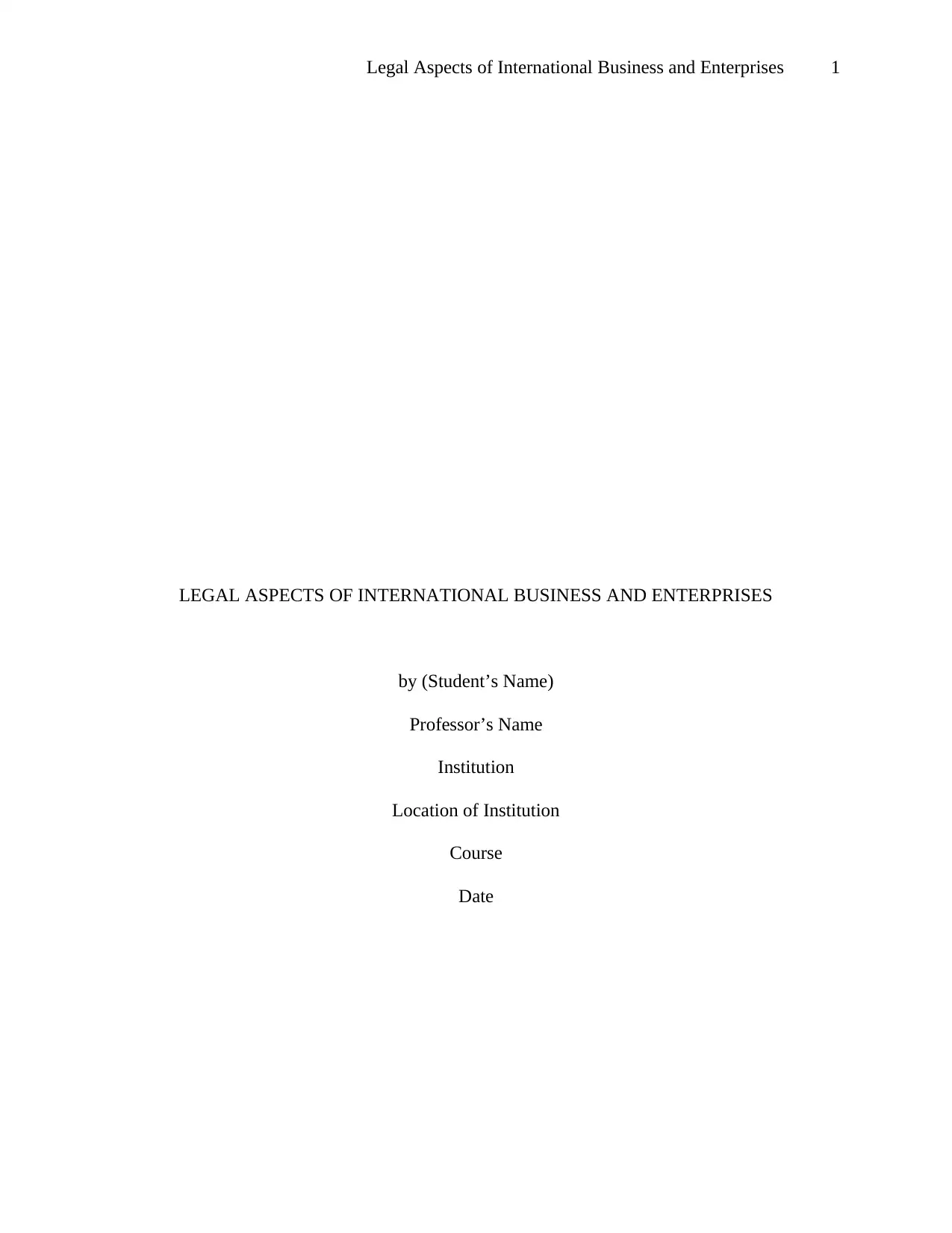
Legal Aspects of International Business and Enterprises 1
LEGAL ASPECTS OF INTERNATIONAL BUSINESS AND ENTERPRISES
by (Student’s Name)
Professor’s Name
Institution
Location of Institution
Course
Date
LEGAL ASPECTS OF INTERNATIONAL BUSINESS AND ENTERPRISES
by (Student’s Name)
Professor’s Name
Institution
Location of Institution
Course
Date
Paraphrase This Document
Need a fresh take? Get an instant paraphrase of this document with our AI Paraphraser
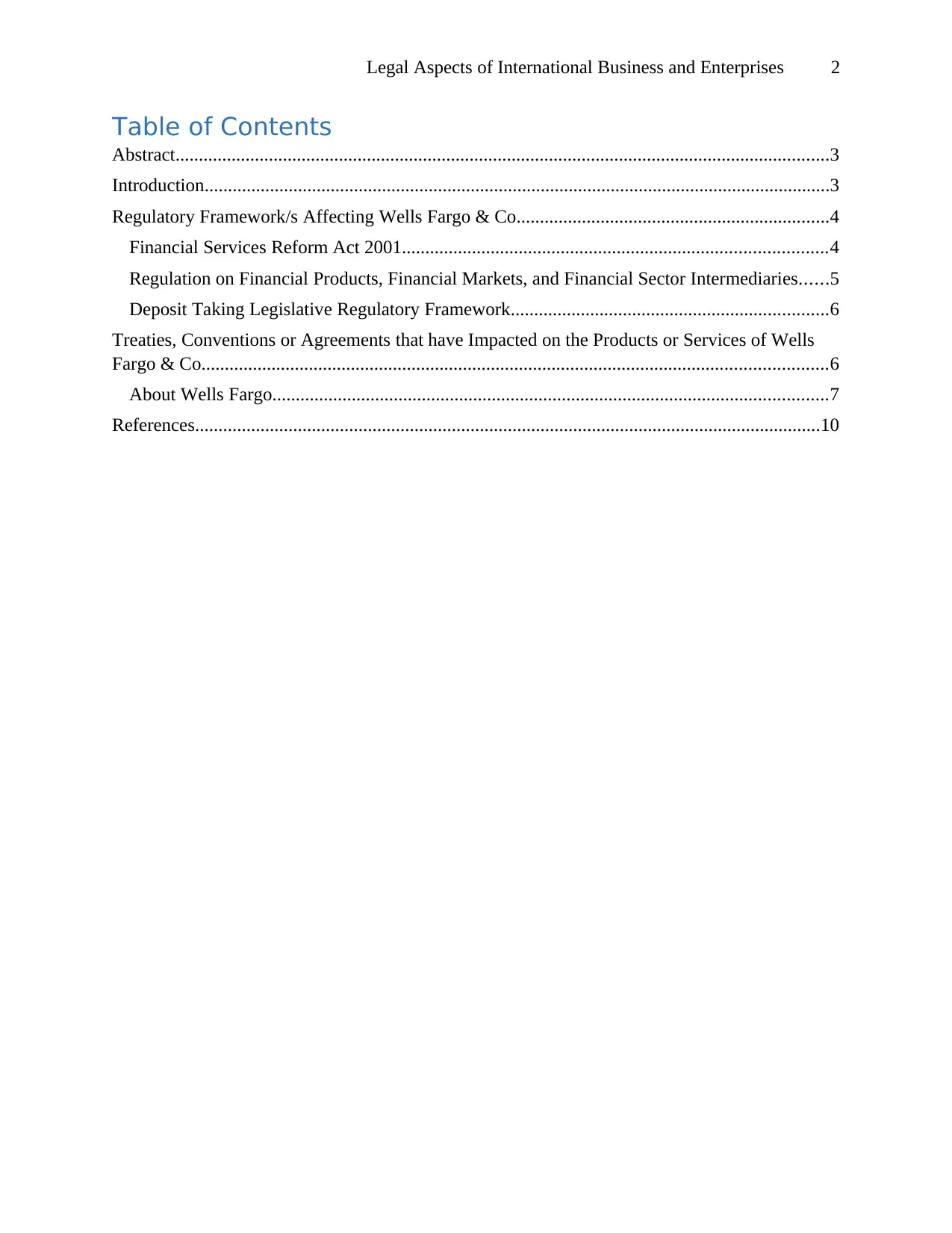
Legal Aspects of International Business and Enterprises 2
Table of Contents
Abstract............................................................................................................................................3
Introduction......................................................................................................................................3
Regulatory Framework/s Affecting Wells Fargo & Co...................................................................4
Financial Services Reform Act 2001...........................................................................................4
Regulation on Financial Products, Financial Markets, and Financial Sector Intermediaries......5
Deposit Taking Legislative Regulatory Framework....................................................................6
Treaties, Conventions or Agreements that have Impacted on the Products or Services of Wells
Fargo & Co......................................................................................................................................6
About Wells Fargo.......................................................................................................................7
References......................................................................................................................................10
Table of Contents
Abstract............................................................................................................................................3
Introduction......................................................................................................................................3
Regulatory Framework/s Affecting Wells Fargo & Co...................................................................4
Financial Services Reform Act 2001...........................................................................................4
Regulation on Financial Products, Financial Markets, and Financial Sector Intermediaries......5
Deposit Taking Legislative Regulatory Framework....................................................................6
Treaties, Conventions or Agreements that have Impacted on the Products or Services of Wells
Fargo & Co......................................................................................................................................6
About Wells Fargo.......................................................................................................................7
References......................................................................................................................................10
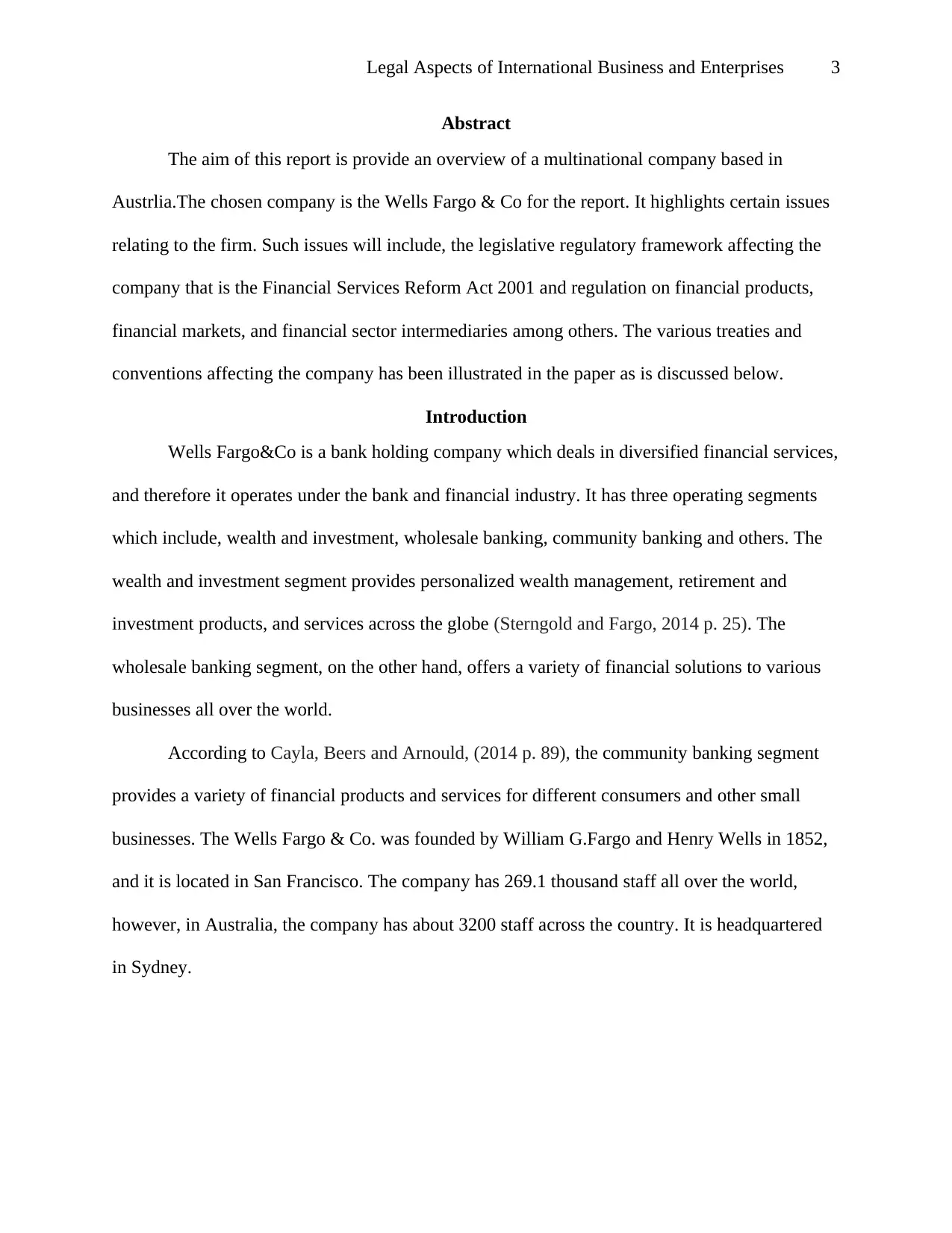
Legal Aspects of International Business and Enterprises 3
Abstract
The aim of this report is provide an overview of a multinational company based in
Austrlia.The chosen company is the Wells Fargo & Co for the report. It highlights certain issues
relating to the firm. Such issues will include, the legislative regulatory framework affecting the
company that is the Financial Services Reform Act 2001 and regulation on financial products,
financial markets, and financial sector intermediaries among others. The various treaties and
conventions affecting the company has been illustrated in the paper as is discussed below.
Introduction
Wells Fargo&Co is a bank holding company which deals in diversified financial services,
and therefore it operates under the bank and financial industry. It has three operating segments
which include, wealth and investment, wholesale banking, community banking and others. The
wealth and investment segment provides personalized wealth management, retirement and
investment products, and services across the globe (Sterngold and Fargo, 2014 p. 25). The
wholesale banking segment, on the other hand, offers a variety of financial solutions to various
businesses all over the world.
According to Cayla, Beers and Arnould, (2014 p. 89), the community banking segment
provides a variety of financial products and services for different consumers and other small
businesses. The Wells Fargo & Co. was founded by William G.Fargo and Henry Wells in 1852,
and it is located in San Francisco. The company has 269.1 thousand staff all over the world,
however, in Australia, the company has about 3200 staff across the country. It is headquartered
in Sydney.
Abstract
The aim of this report is provide an overview of a multinational company based in
Austrlia.The chosen company is the Wells Fargo & Co for the report. It highlights certain issues
relating to the firm. Such issues will include, the legislative regulatory framework affecting the
company that is the Financial Services Reform Act 2001 and regulation on financial products,
financial markets, and financial sector intermediaries among others. The various treaties and
conventions affecting the company has been illustrated in the paper as is discussed below.
Introduction
Wells Fargo&Co is a bank holding company which deals in diversified financial services,
and therefore it operates under the bank and financial industry. It has three operating segments
which include, wealth and investment, wholesale banking, community banking and others. The
wealth and investment segment provides personalized wealth management, retirement and
investment products, and services across the globe (Sterngold and Fargo, 2014 p. 25). The
wholesale banking segment, on the other hand, offers a variety of financial solutions to various
businesses all over the world.
According to Cayla, Beers and Arnould, (2014 p. 89), the community banking segment
provides a variety of financial products and services for different consumers and other small
businesses. The Wells Fargo & Co. was founded by William G.Fargo and Henry Wells in 1852,
and it is located in San Francisco. The company has 269.1 thousand staff all over the world,
however, in Australia, the company has about 3200 staff across the country. It is headquartered
in Sydney.
⊘ This is a preview!⊘
Do you want full access?
Subscribe today to unlock all pages.

Trusted by 1+ million students worldwide
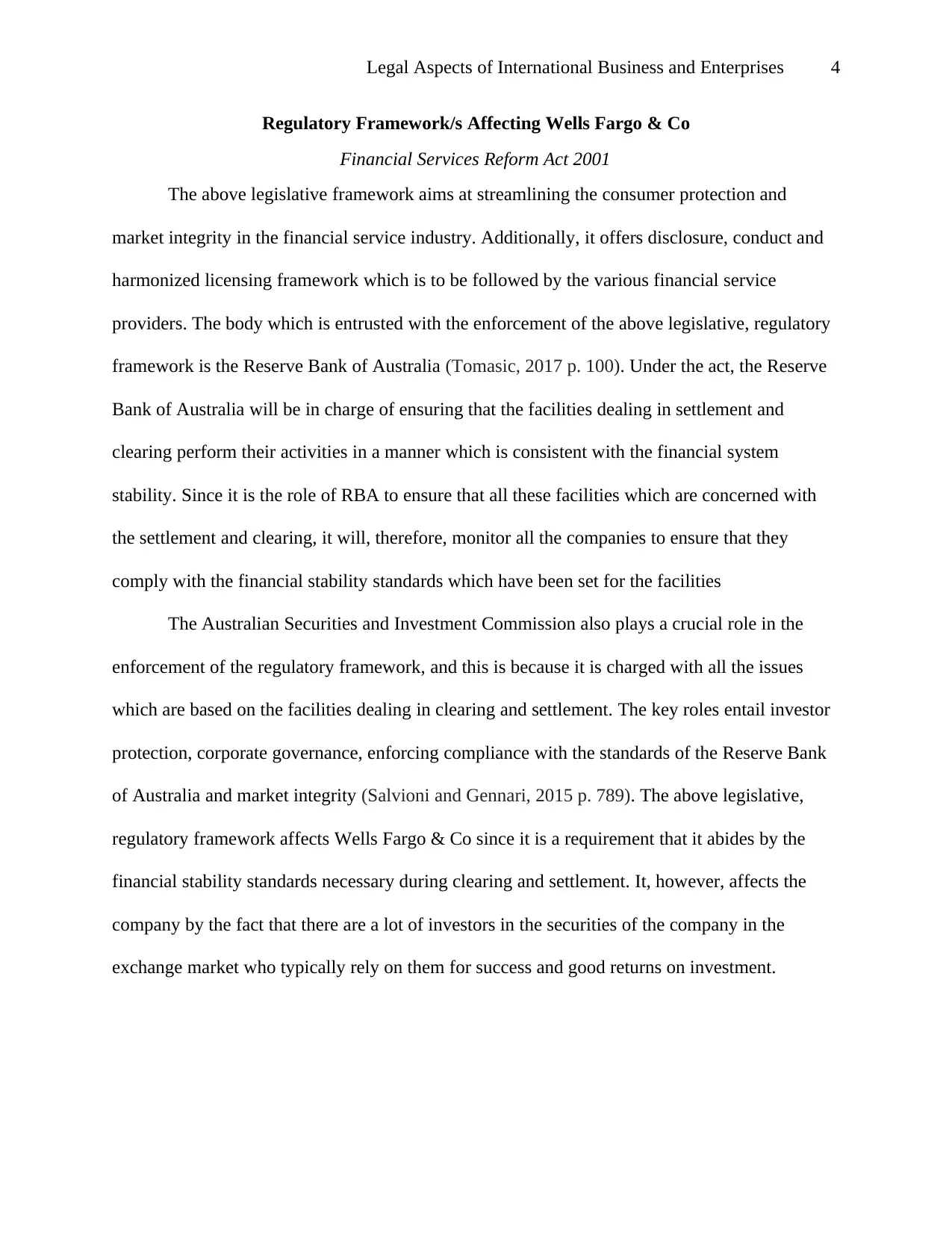
Legal Aspects of International Business and Enterprises 4
Regulatory Framework/s Affecting Wells Fargo & Co
Financial Services Reform Act 2001
The above legislative framework aims at streamlining the consumer protection and
market integrity in the financial service industry. Additionally, it offers disclosure, conduct and
harmonized licensing framework which is to be followed by the various financial service
providers. The body which is entrusted with the enforcement of the above legislative, regulatory
framework is the Reserve Bank of Australia (Tomasic, 2017 p. 100). Under the act, the Reserve
Bank of Australia will be in charge of ensuring that the facilities dealing in settlement and
clearing perform their activities in a manner which is consistent with the financial system
stability. Since it is the role of RBA to ensure that all these facilities which are concerned with
the settlement and clearing, it will, therefore, monitor all the companies to ensure that they
comply with the financial stability standards which have been set for the facilities
The Australian Securities and Investment Commission also plays a crucial role in the
enforcement of the regulatory framework, and this is because it is charged with all the issues
which are based on the facilities dealing in clearing and settlement. The key roles entail investor
protection, corporate governance, enforcing compliance with the standards of the Reserve Bank
of Australia and market integrity (Salvioni and Gennari, 2015 p. 789). The above legislative,
regulatory framework affects Wells Fargo & Co since it is a requirement that it abides by the
financial stability standards necessary during clearing and settlement. It, however, affects the
company by the fact that there are a lot of investors in the securities of the company in the
exchange market who typically rely on them for success and good returns on investment.
Regulatory Framework/s Affecting Wells Fargo & Co
Financial Services Reform Act 2001
The above legislative framework aims at streamlining the consumer protection and
market integrity in the financial service industry. Additionally, it offers disclosure, conduct and
harmonized licensing framework which is to be followed by the various financial service
providers. The body which is entrusted with the enforcement of the above legislative, regulatory
framework is the Reserve Bank of Australia (Tomasic, 2017 p. 100). Under the act, the Reserve
Bank of Australia will be in charge of ensuring that the facilities dealing in settlement and
clearing perform their activities in a manner which is consistent with the financial system
stability. Since it is the role of RBA to ensure that all these facilities which are concerned with
the settlement and clearing, it will, therefore, monitor all the companies to ensure that they
comply with the financial stability standards which have been set for the facilities
The Australian Securities and Investment Commission also plays a crucial role in the
enforcement of the regulatory framework, and this is because it is charged with all the issues
which are based on the facilities dealing in clearing and settlement. The key roles entail investor
protection, corporate governance, enforcing compliance with the standards of the Reserve Bank
of Australia and market integrity (Salvioni and Gennari, 2015 p. 789). The above legislative,
regulatory framework affects Wells Fargo & Co since it is a requirement that it abides by the
financial stability standards necessary during clearing and settlement. It, however, affects the
company by the fact that there are a lot of investors in the securities of the company in the
exchange market who typically rely on them for success and good returns on investment.
Paraphrase This Document
Need a fresh take? Get an instant paraphrase of this document with our AI Paraphraser
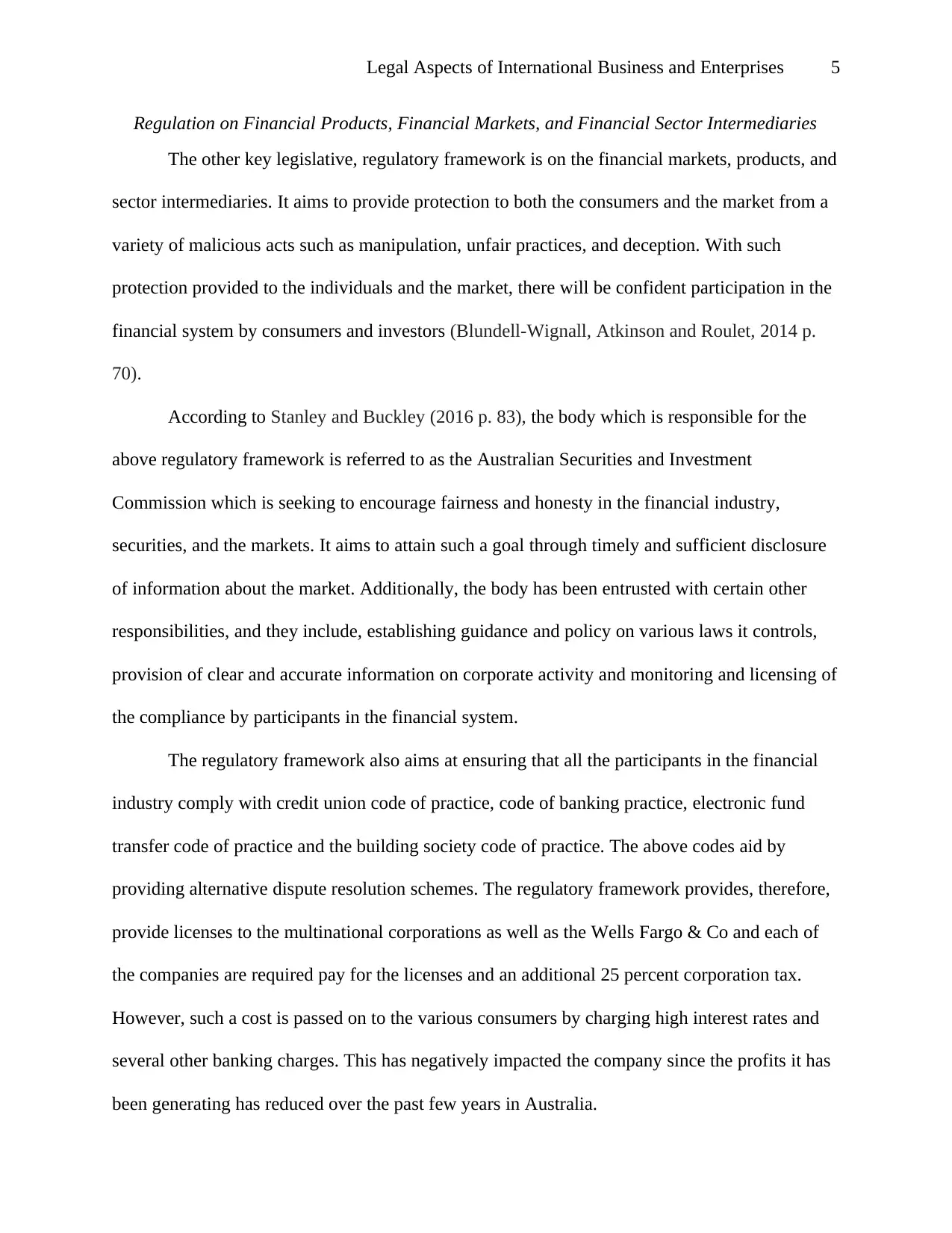
Legal Aspects of International Business and Enterprises 5
Regulation on Financial Products, Financial Markets, and Financial Sector Intermediaries
The other key legislative, regulatory framework is on the financial markets, products, and
sector intermediaries. It aims to provide protection to both the consumers and the market from a
variety of malicious acts such as manipulation, unfair practices, and deception. With such
protection provided to the individuals and the market, there will be confident participation in the
financial system by consumers and investors (Blundell-Wignall, Atkinson and Roulet, 2014 p.
70).
According to Stanley and Buckley (2016 p. 83), the body which is responsible for the
above regulatory framework is referred to as the Australian Securities and Investment
Commission which is seeking to encourage fairness and honesty in the financial industry,
securities, and the markets. It aims to attain such a goal through timely and sufficient disclosure
of information about the market. Additionally, the body has been entrusted with certain other
responsibilities, and they include, establishing guidance and policy on various laws it controls,
provision of clear and accurate information on corporate activity and monitoring and licensing of
the compliance by participants in the financial system.
The regulatory framework also aims at ensuring that all the participants in the financial
industry comply with credit union code of practice, code of banking practice, electronic fund
transfer code of practice and the building society code of practice. The above codes aid by
providing alternative dispute resolution schemes. The regulatory framework provides, therefore,
provide licenses to the multinational corporations as well as the Wells Fargo & Co and each of
the companies are required pay for the licenses and an additional 25 percent corporation tax.
However, such a cost is passed on to the various consumers by charging high interest rates and
several other banking charges. This has negatively impacted the company since the profits it has
been generating has reduced over the past few years in Australia.
Regulation on Financial Products, Financial Markets, and Financial Sector Intermediaries
The other key legislative, regulatory framework is on the financial markets, products, and
sector intermediaries. It aims to provide protection to both the consumers and the market from a
variety of malicious acts such as manipulation, unfair practices, and deception. With such
protection provided to the individuals and the market, there will be confident participation in the
financial system by consumers and investors (Blundell-Wignall, Atkinson and Roulet, 2014 p.
70).
According to Stanley and Buckley (2016 p. 83), the body which is responsible for the
above regulatory framework is referred to as the Australian Securities and Investment
Commission which is seeking to encourage fairness and honesty in the financial industry,
securities, and the markets. It aims to attain such a goal through timely and sufficient disclosure
of information about the market. Additionally, the body has been entrusted with certain other
responsibilities, and they include, establishing guidance and policy on various laws it controls,
provision of clear and accurate information on corporate activity and monitoring and licensing of
the compliance by participants in the financial system.
The regulatory framework also aims at ensuring that all the participants in the financial
industry comply with credit union code of practice, code of banking practice, electronic fund
transfer code of practice and the building society code of practice. The above codes aid by
providing alternative dispute resolution schemes. The regulatory framework provides, therefore,
provide licenses to the multinational corporations as well as the Wells Fargo & Co and each of
the companies are required pay for the licenses and an additional 25 percent corporation tax.
However, such a cost is passed on to the various consumers by charging high interest rates and
several other banking charges. This has negatively impacted the company since the profits it has
been generating has reduced over the past few years in Australia.
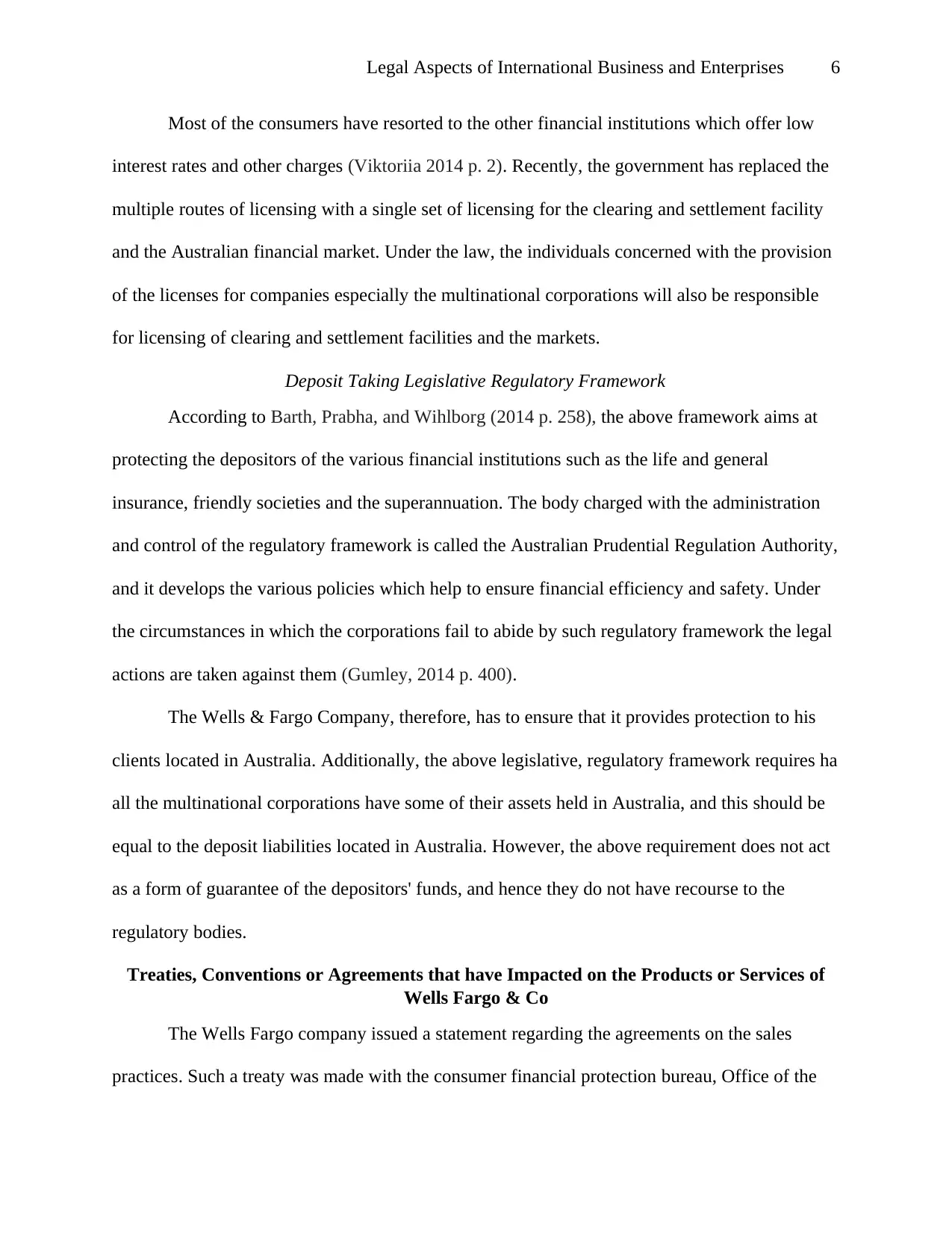
Legal Aspects of International Business and Enterprises 6
Most of the consumers have resorted to the other financial institutions which offer low
interest rates and other charges (Viktoriia 2014 p. 2). Recently, the government has replaced the
multiple routes of licensing with a single set of licensing for the clearing and settlement facility
and the Australian financial market. Under the law, the individuals concerned with the provision
of the licenses for companies especially the multinational corporations will also be responsible
for licensing of clearing and settlement facilities and the markets.
Deposit Taking Legislative Regulatory Framework
According to Barth, Prabha, and Wihlborg (2014 p. 258), the above framework aims at
protecting the depositors of the various financial institutions such as the life and general
insurance, friendly societies and the superannuation. The body charged with the administration
and control of the regulatory framework is called the Australian Prudential Regulation Authority,
and it develops the various policies which help to ensure financial efficiency and safety. Under
the circumstances in which the corporations fail to abide by such regulatory framework the legal
actions are taken against them (Gumley, 2014 p. 400).
The Wells & Fargo Company, therefore, has to ensure that it provides protection to his
clients located in Australia. Additionally, the above legislative, regulatory framework requires ha
all the multinational corporations have some of their assets held in Australia, and this should be
equal to the deposit liabilities located in Australia. However, the above requirement does not act
as a form of guarantee of the depositors' funds, and hence they do not have recourse to the
regulatory bodies.
Treaties, Conventions or Agreements that have Impacted on the Products or Services of
Wells Fargo & Co
The Wells Fargo company issued a statement regarding the agreements on the sales
practices. Such a treaty was made with the consumer financial protection bureau, Office of the
Most of the consumers have resorted to the other financial institutions which offer low
interest rates and other charges (Viktoriia 2014 p. 2). Recently, the government has replaced the
multiple routes of licensing with a single set of licensing for the clearing and settlement facility
and the Australian financial market. Under the law, the individuals concerned with the provision
of the licenses for companies especially the multinational corporations will also be responsible
for licensing of clearing and settlement facilities and the markets.
Deposit Taking Legislative Regulatory Framework
According to Barth, Prabha, and Wihlborg (2014 p. 258), the above framework aims at
protecting the depositors of the various financial institutions such as the life and general
insurance, friendly societies and the superannuation. The body charged with the administration
and control of the regulatory framework is called the Australian Prudential Regulation Authority,
and it develops the various policies which help to ensure financial efficiency and safety. Under
the circumstances in which the corporations fail to abide by such regulatory framework the legal
actions are taken against them (Gumley, 2014 p. 400).
The Wells & Fargo Company, therefore, has to ensure that it provides protection to his
clients located in Australia. Additionally, the above legislative, regulatory framework requires ha
all the multinational corporations have some of their assets held in Australia, and this should be
equal to the deposit liabilities located in Australia. However, the above requirement does not act
as a form of guarantee of the depositors' funds, and hence they do not have recourse to the
regulatory bodies.
Treaties, Conventions or Agreements that have Impacted on the Products or Services of
Wells Fargo & Co
The Wells Fargo company issued a statement regarding the agreements on the sales
practices. Such a treaty was made with the consumer financial protection bureau, Office of the
⊘ This is a preview!⊘
Do you want full access?
Subscribe today to unlock all pages.

Trusted by 1+ million students worldwide
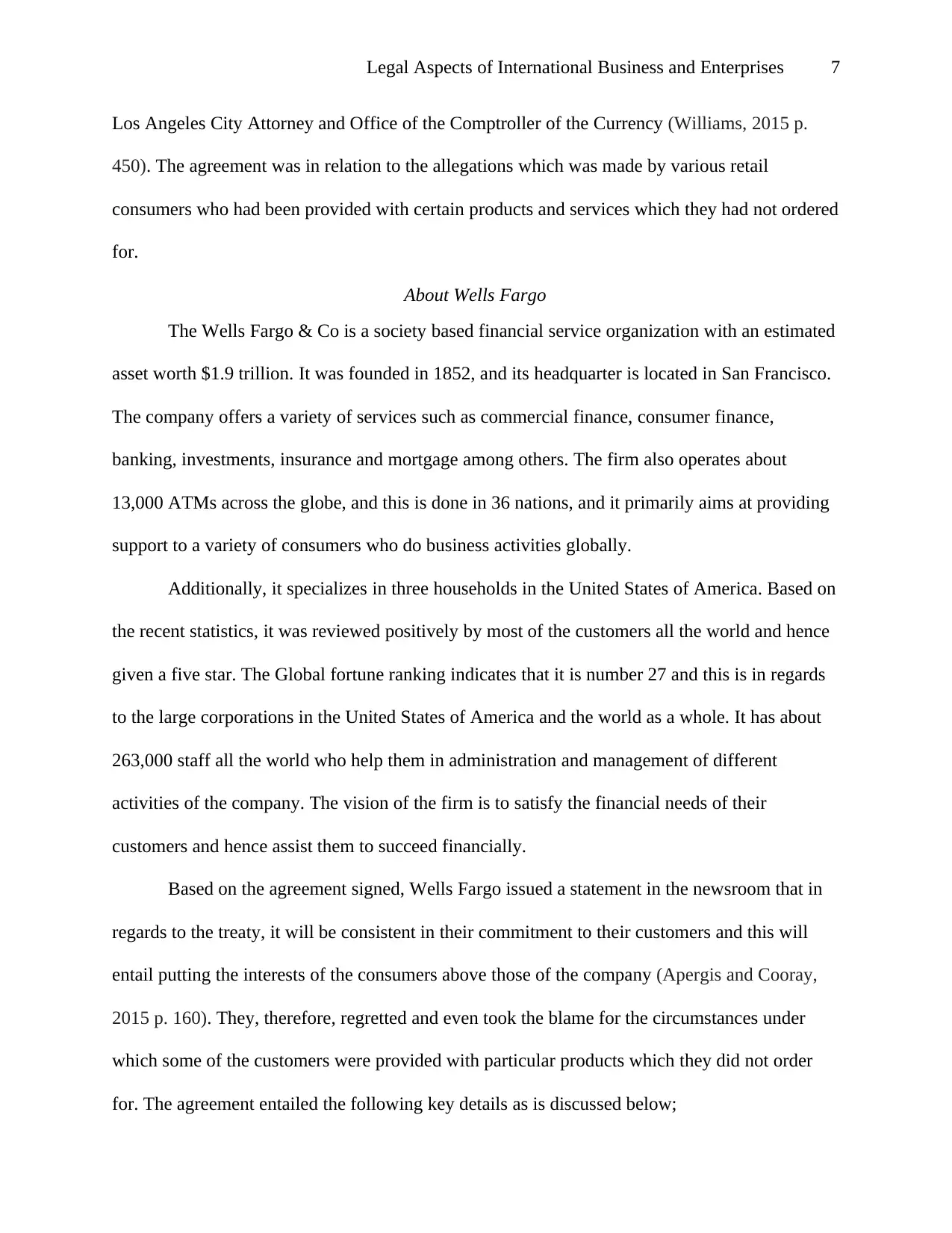
Legal Aspects of International Business and Enterprises 7
Los Angeles City Attorney and Office of the Comptroller of the Currency (Williams, 2015 p.
450). The agreement was in relation to the allegations which was made by various retail
consumers who had been provided with certain products and services which they had not ordered
for.
About Wells Fargo
The Wells Fargo & Co is a society based financial service organization with an estimated
asset worth $1.9 trillion. It was founded in 1852, and its headquarter is located in San Francisco.
The company offers a variety of services such as commercial finance, consumer finance,
banking, investments, insurance and mortgage among others. The firm also operates about
13,000 ATMs across the globe, and this is done in 36 nations, and it primarily aims at providing
support to a variety of consumers who do business activities globally.
Additionally, it specializes in three households in the United States of America. Based on
the recent statistics, it was reviewed positively by most of the customers all the world and hence
given a five star. The Global fortune ranking indicates that it is number 27 and this is in regards
to the large corporations in the United States of America and the world as a whole. It has about
263,000 staff all the world who help them in administration and management of different
activities of the company. The vision of the firm is to satisfy the financial needs of their
customers and hence assist them to succeed financially.
Based on the agreement signed, Wells Fargo issued a statement in the newsroom that in
regards to the treaty, it will be consistent in their commitment to their customers and this will
entail putting the interests of the consumers above those of the company (Apergis and Cooray,
2015 p. 160). They, therefore, regretted and even took the blame for the circumstances under
which some of the customers were provided with particular products which they did not order
for. The agreement entailed the following key details as is discussed below;
Los Angeles City Attorney and Office of the Comptroller of the Currency (Williams, 2015 p.
450). The agreement was in relation to the allegations which was made by various retail
consumers who had been provided with certain products and services which they had not ordered
for.
About Wells Fargo
The Wells Fargo & Co is a society based financial service organization with an estimated
asset worth $1.9 trillion. It was founded in 1852, and its headquarter is located in San Francisco.
The company offers a variety of services such as commercial finance, consumer finance,
banking, investments, insurance and mortgage among others. The firm also operates about
13,000 ATMs across the globe, and this is done in 36 nations, and it primarily aims at providing
support to a variety of consumers who do business activities globally.
Additionally, it specializes in three households in the United States of America. Based on
the recent statistics, it was reviewed positively by most of the customers all the world and hence
given a five star. The Global fortune ranking indicates that it is number 27 and this is in regards
to the large corporations in the United States of America and the world as a whole. It has about
263,000 staff all the world who help them in administration and management of different
activities of the company. The vision of the firm is to satisfy the financial needs of their
customers and hence assist them to succeed financially.
Based on the agreement signed, Wells Fargo issued a statement in the newsroom that in
regards to the treaty, it will be consistent in their commitment to their customers and this will
entail putting the interests of the consumers above those of the company (Apergis and Cooray,
2015 p. 160). They, therefore, regretted and even took the blame for the circumstances under
which some of the customers were provided with particular products which they did not order
for. The agreement entailed the following key details as is discussed below;
Paraphrase This Document
Need a fresh take? Get an instant paraphrase of this document with our AI Paraphraser
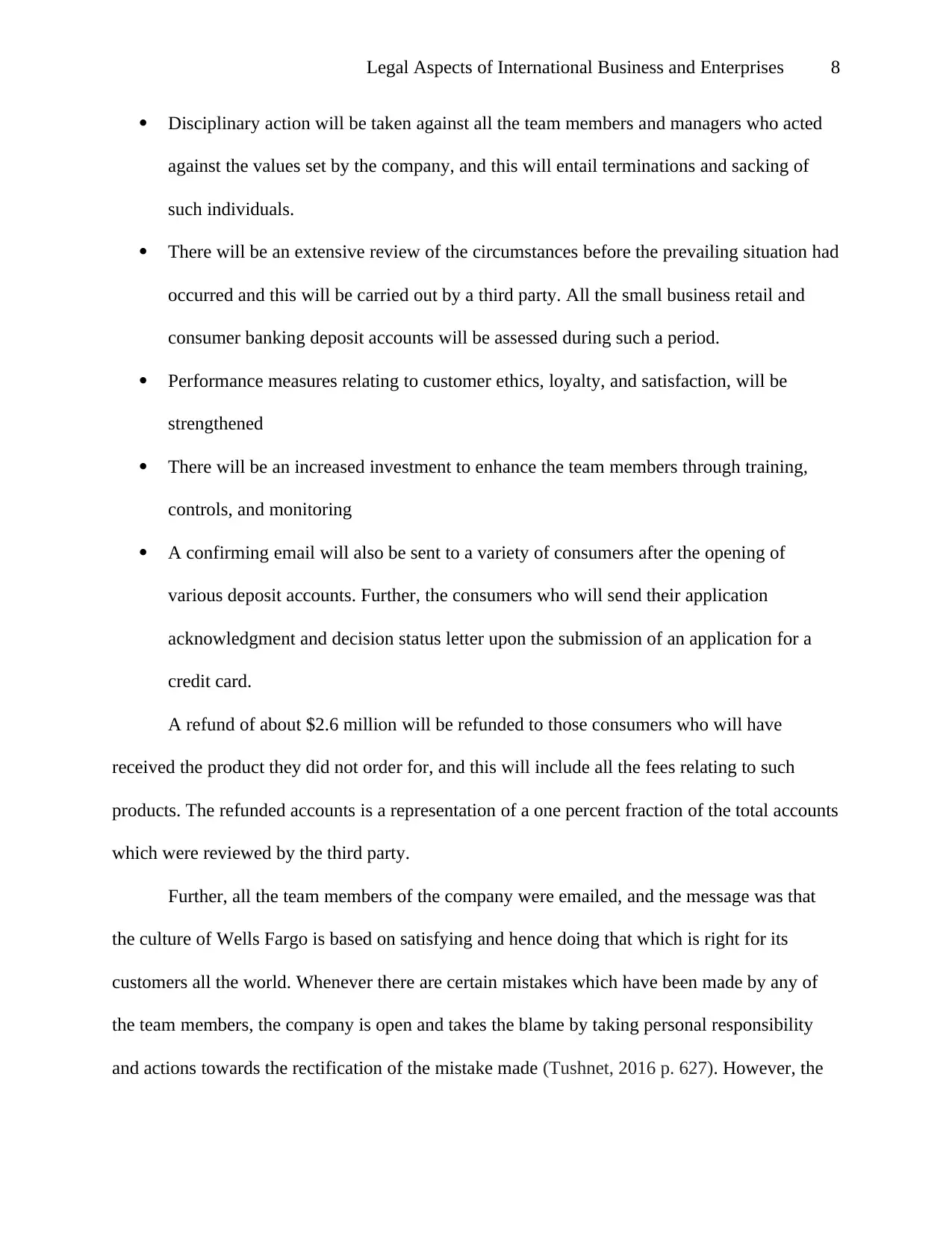
Legal Aspects of International Business and Enterprises 8
Disciplinary action will be taken against all the team members and managers who acted
against the values set by the company, and this will entail terminations and sacking of
such individuals.
There will be an extensive review of the circumstances before the prevailing situation had
occurred and this will be carried out by a third party. All the small business retail and
consumer banking deposit accounts will be assessed during such a period.
Performance measures relating to customer ethics, loyalty, and satisfaction, will be
strengthened
There will be an increased investment to enhance the team members through training,
controls, and monitoring
A confirming email will also be sent to a variety of consumers after the opening of
various deposit accounts. Further, the consumers who will send their application
acknowledgment and decision status letter upon the submission of an application for a
credit card.
A refund of about $2.6 million will be refunded to those consumers who will have
received the product they did not order for, and this will include all the fees relating to such
products. The refunded accounts is a representation of a one percent fraction of the total accounts
which were reviewed by the third party.
Further, all the team members of the company were emailed, and the message was that
the culture of Wells Fargo is based on satisfying and hence doing that which is right for its
customers all the world. Whenever there are certain mistakes which have been made by any of
the team members, the company is open and takes the blame by taking personal responsibility
and actions towards the rectification of the mistake made (Tushnet, 2016 p. 627). However, the
Disciplinary action will be taken against all the team members and managers who acted
against the values set by the company, and this will entail terminations and sacking of
such individuals.
There will be an extensive review of the circumstances before the prevailing situation had
occurred and this will be carried out by a third party. All the small business retail and
consumer banking deposit accounts will be assessed during such a period.
Performance measures relating to customer ethics, loyalty, and satisfaction, will be
strengthened
There will be an increased investment to enhance the team members through training,
controls, and monitoring
A confirming email will also be sent to a variety of consumers after the opening of
various deposit accounts. Further, the consumers who will send their application
acknowledgment and decision status letter upon the submission of an application for a
credit card.
A refund of about $2.6 million will be refunded to those consumers who will have
received the product they did not order for, and this will include all the fees relating to such
products. The refunded accounts is a representation of a one percent fraction of the total accounts
which were reviewed by the third party.
Further, all the team members of the company were emailed, and the message was that
the culture of Wells Fargo is based on satisfying and hence doing that which is right for its
customers all the world. Whenever there are certain mistakes which have been made by any of
the team members, the company is open and takes the blame by taking personal responsibility
and actions towards the rectification of the mistake made (Tushnet, 2016 p. 627). However, the
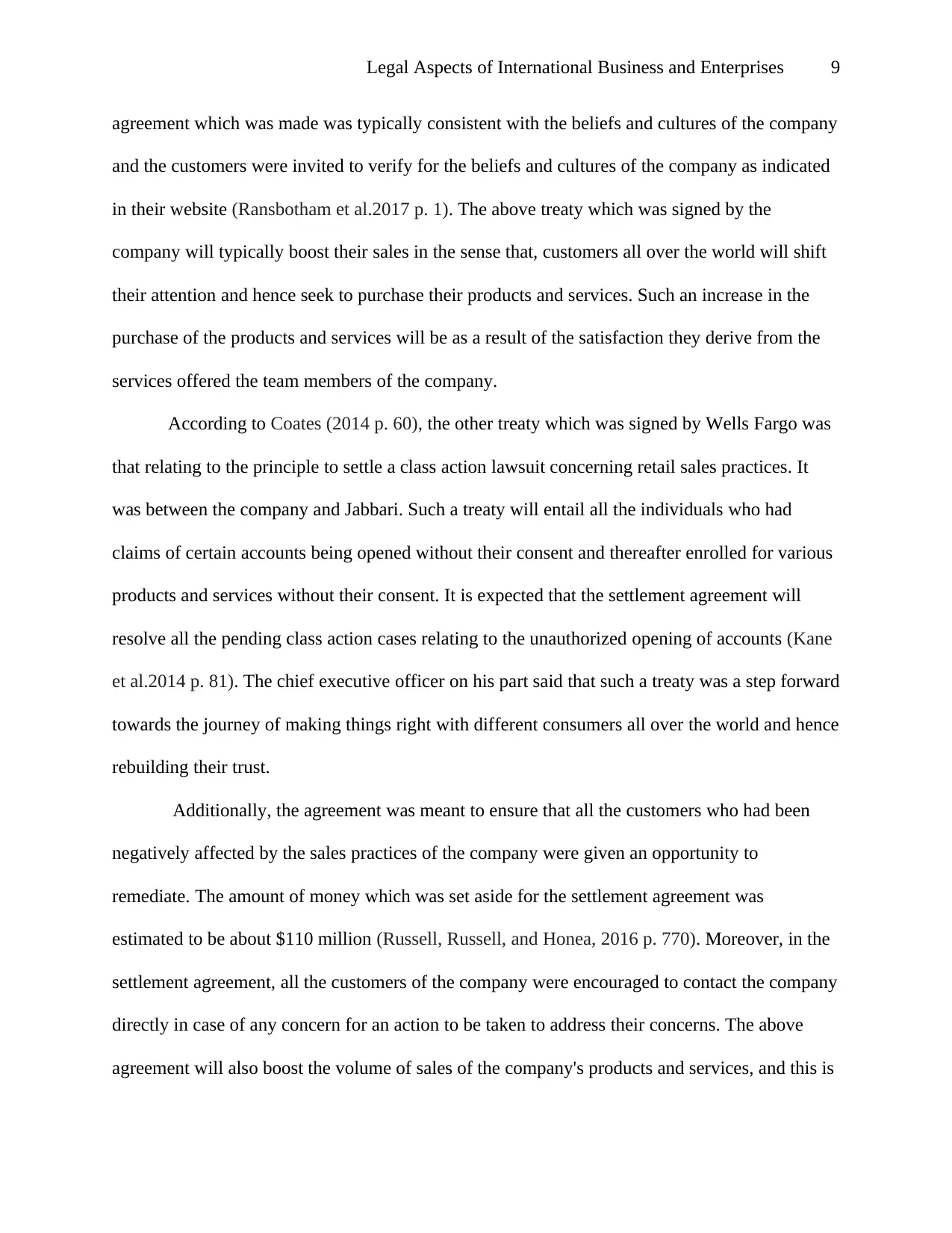
Legal Aspects of International Business and Enterprises 9
agreement which was made was typically consistent with the beliefs and cultures of the company
and the customers were invited to verify for the beliefs and cultures of the company as indicated
in their website (Ransbotham et al.2017 p. 1). The above treaty which was signed by the
company will typically boost their sales in the sense that, customers all over the world will shift
their attention and hence seek to purchase their products and services. Such an increase in the
purchase of the products and services will be as a result of the satisfaction they derive from the
services offered the team members of the company.
According to Coates (2014 p. 60), the other treaty which was signed by Wells Fargo was
that relating to the principle to settle a class action lawsuit concerning retail sales practices. It
was between the company and Jabbari. Such a treaty will entail all the individuals who had
claims of certain accounts being opened without their consent and thereafter enrolled for various
products and services without their consent. It is expected that the settlement agreement will
resolve all the pending class action cases relating to the unauthorized opening of accounts (Kane
et al.2014 p. 81). The chief executive officer on his part said that such a treaty was a step forward
towards the journey of making things right with different consumers all over the world and hence
rebuilding their trust.
Additionally, the agreement was meant to ensure that all the customers who had been
negatively affected by the sales practices of the company were given an opportunity to
remediate. The amount of money which was set aside for the settlement agreement was
estimated to be about $110 million (Russell, Russell, and Honea, 2016 p. 770). Moreover, in the
settlement agreement, all the customers of the company were encouraged to contact the company
directly in case of any concern for an action to be taken to address their concerns. The above
agreement will also boost the volume of sales of the company's products and services, and this is
agreement which was made was typically consistent with the beliefs and cultures of the company
and the customers were invited to verify for the beliefs and cultures of the company as indicated
in their website (Ransbotham et al.2017 p. 1). The above treaty which was signed by the
company will typically boost their sales in the sense that, customers all over the world will shift
their attention and hence seek to purchase their products and services. Such an increase in the
purchase of the products and services will be as a result of the satisfaction they derive from the
services offered the team members of the company.
According to Coates (2014 p. 60), the other treaty which was signed by Wells Fargo was
that relating to the principle to settle a class action lawsuit concerning retail sales practices. It
was between the company and Jabbari. Such a treaty will entail all the individuals who had
claims of certain accounts being opened without their consent and thereafter enrolled for various
products and services without their consent. It is expected that the settlement agreement will
resolve all the pending class action cases relating to the unauthorized opening of accounts (Kane
et al.2014 p. 81). The chief executive officer on his part said that such a treaty was a step forward
towards the journey of making things right with different consumers all over the world and hence
rebuilding their trust.
Additionally, the agreement was meant to ensure that all the customers who had been
negatively affected by the sales practices of the company were given an opportunity to
remediate. The amount of money which was set aside for the settlement agreement was
estimated to be about $110 million (Russell, Russell, and Honea, 2016 p. 770). Moreover, in the
settlement agreement, all the customers of the company were encouraged to contact the company
directly in case of any concern for an action to be taken to address their concerns. The above
agreement will also boost the volume of sales of the company's products and services, and this is
⊘ This is a preview!⊘
Do you want full access?
Subscribe today to unlock all pages.

Trusted by 1+ million students worldwide
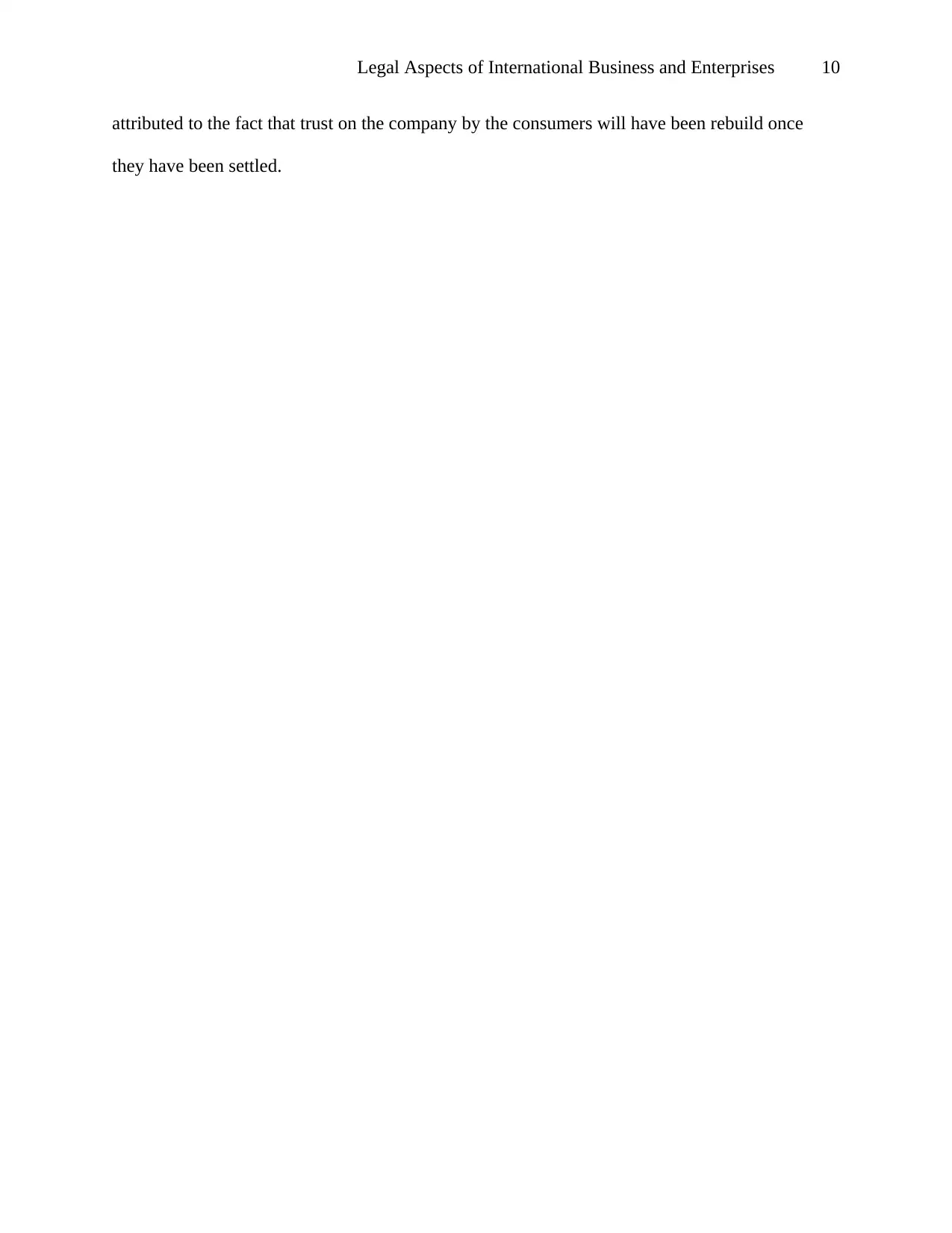
Legal Aspects of International Business and Enterprises 10
attributed to the fact that trust on the company by the consumers will have been rebuild once
they have been settled.
attributed to the fact that trust on the company by the consumers will have been rebuild once
they have been settled.
Paraphrase This Document
Need a fresh take? Get an instant paraphrase of this document with our AI Paraphraser
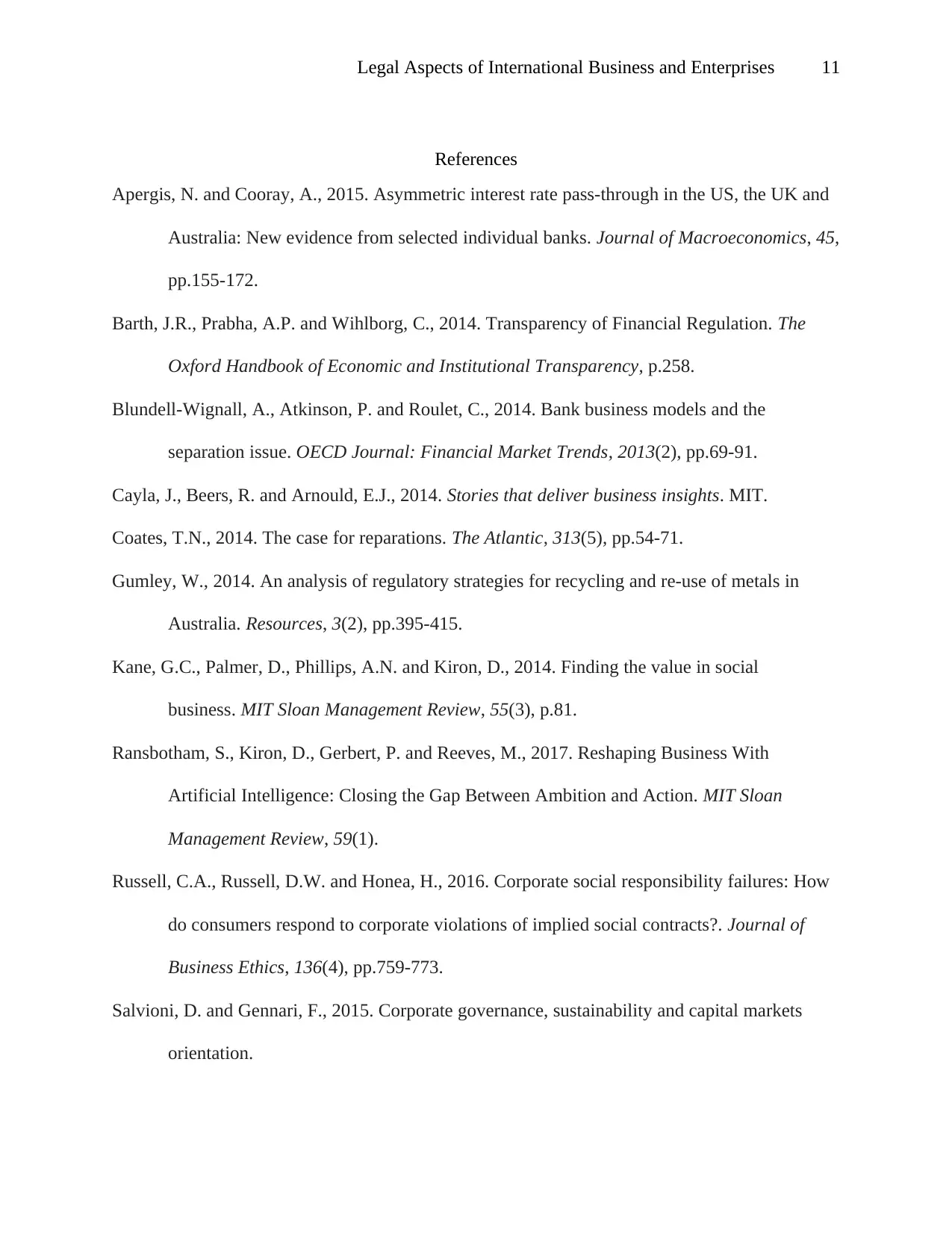
Legal Aspects of International Business and Enterprises 11
References
Apergis, N. and Cooray, A., 2015. Asymmetric interest rate pass-through in the US, the UK and
Australia: New evidence from selected individual banks. Journal of Macroeconomics, 45,
pp.155-172.
Barth, J.R., Prabha, A.P. and Wihlborg, C., 2014. Transparency of Financial Regulation. The
Oxford Handbook of Economic and Institutional Transparency, p.258.
Blundell-Wignall, A., Atkinson, P. and Roulet, C., 2014. Bank business models and the
separation issue. OECD Journal: Financial Market Trends, 2013(2), pp.69-91.
Cayla, J., Beers, R. and Arnould, E.J., 2014. Stories that deliver business insights. MIT.
Coates, T.N., 2014. The case for reparations. The Atlantic, 313(5), pp.54-71.
Gumley, W., 2014. An analysis of regulatory strategies for recycling and re-use of metals in
Australia. Resources, 3(2), pp.395-415.
Kane, G.C., Palmer, D., Phillips, A.N. and Kiron, D., 2014. Finding the value in social
business. MIT Sloan Management Review, 55(3), p.81.
Ransbotham, S., Kiron, D., Gerbert, P. and Reeves, M., 2017. Reshaping Business With
Artificial Intelligence: Closing the Gap Between Ambition and Action. MIT Sloan
Management Review, 59(1).
Russell, C.A., Russell, D.W. and Honea, H., 2016. Corporate social responsibility failures: How
do consumers respond to corporate violations of implied social contracts?. Journal of
Business Ethics, 136(4), pp.759-773.
Salvioni, D. and Gennari, F., 2015. Corporate governance, sustainability and capital markets
orientation.
References
Apergis, N. and Cooray, A., 2015. Asymmetric interest rate pass-through in the US, the UK and
Australia: New evidence from selected individual banks. Journal of Macroeconomics, 45,
pp.155-172.
Barth, J.R., Prabha, A.P. and Wihlborg, C., 2014. Transparency of Financial Regulation. The
Oxford Handbook of Economic and Institutional Transparency, p.258.
Blundell-Wignall, A., Atkinson, P. and Roulet, C., 2014. Bank business models and the
separation issue. OECD Journal: Financial Market Trends, 2013(2), pp.69-91.
Cayla, J., Beers, R. and Arnould, E.J., 2014. Stories that deliver business insights. MIT.
Coates, T.N., 2014. The case for reparations. The Atlantic, 313(5), pp.54-71.
Gumley, W., 2014. An analysis of regulatory strategies for recycling and re-use of metals in
Australia. Resources, 3(2), pp.395-415.
Kane, G.C., Palmer, D., Phillips, A.N. and Kiron, D., 2014. Finding the value in social
business. MIT Sloan Management Review, 55(3), p.81.
Ransbotham, S., Kiron, D., Gerbert, P. and Reeves, M., 2017. Reshaping Business With
Artificial Intelligence: Closing the Gap Between Ambition and Action. MIT Sloan
Management Review, 59(1).
Russell, C.A., Russell, D.W. and Honea, H., 2016. Corporate social responsibility failures: How
do consumers respond to corporate violations of implied social contracts?. Journal of
Business Ethics, 136(4), pp.759-773.
Salvioni, D. and Gennari, F., 2015. Corporate governance, sustainability and capital markets
orientation.
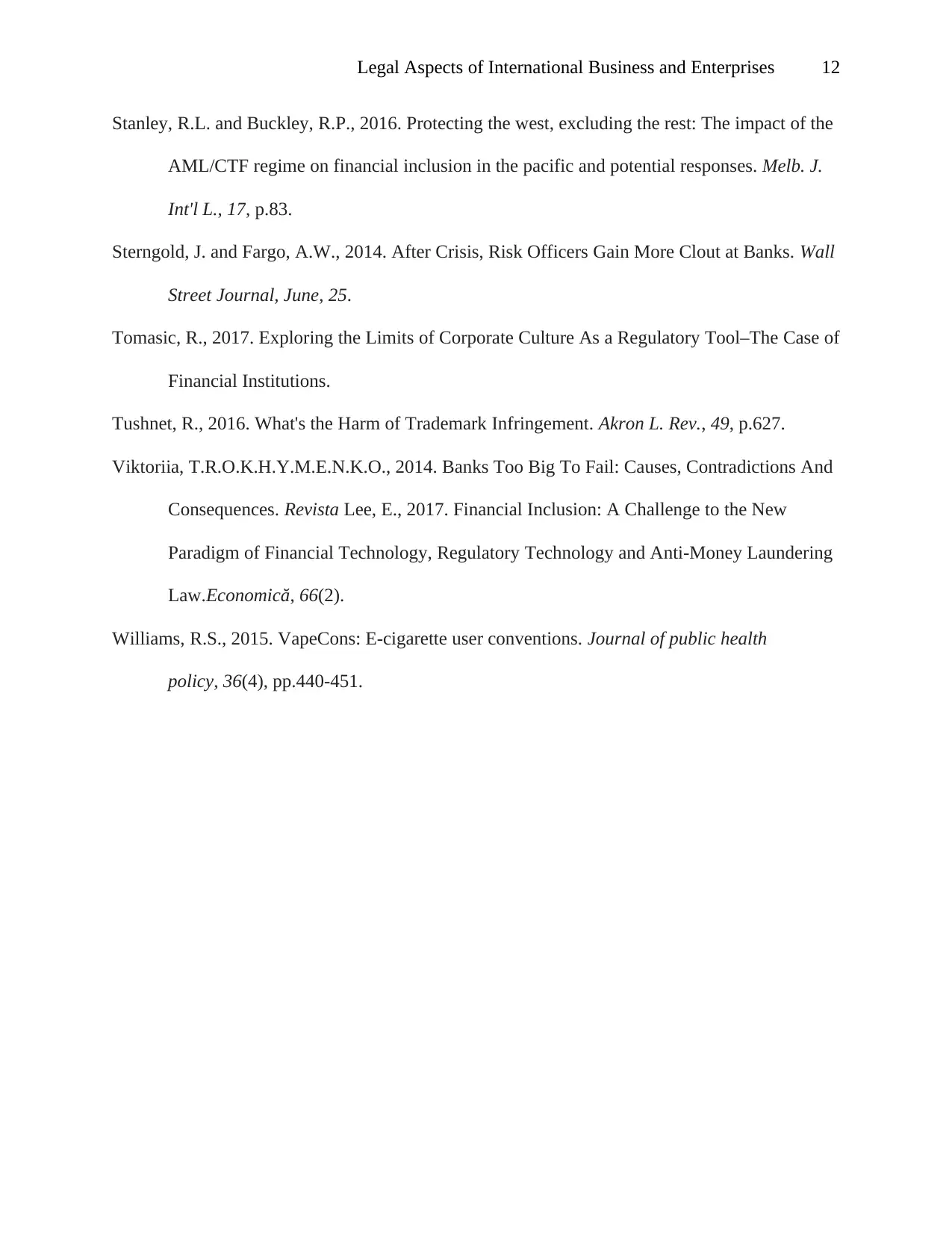
Legal Aspects of International Business and Enterprises 12
Stanley, R.L. and Buckley, R.P., 2016. Protecting the west, excluding the rest: The impact of the
AML/CTF regime on financial inclusion in the pacific and potential responses. Melb. J.
Int'l L., 17, p.83.
Sterngold, J. and Fargo, A.W., 2014. After Crisis, Risk Officers Gain More Clout at Banks. Wall
Street Journal, June, 25.
Tomasic, R., 2017. Exploring the Limits of Corporate Culture As a Regulatory Tool–The Case of
Financial Institutions.
Tushnet, R., 2016. What's the Harm of Trademark Infringement. Akron L. Rev., 49, p.627.
Viktoriia, T.R.O.K.H.Y.M.E.N.K.O., 2014. Banks Too Big To Fail: Causes, Contradictions And
Consequences. Revista Lee, E., 2017. Financial Inclusion: A Challenge to the New
Paradigm of Financial Technology, Regulatory Technology and Anti-Money Laundering
Law.Economică, 66(2).
Williams, R.S., 2015. VapeCons: E-cigarette user conventions. Journal of public health
policy, 36(4), pp.440-451.
Stanley, R.L. and Buckley, R.P., 2016. Protecting the west, excluding the rest: The impact of the
AML/CTF regime on financial inclusion in the pacific and potential responses. Melb. J.
Int'l L., 17, p.83.
Sterngold, J. and Fargo, A.W., 2014. After Crisis, Risk Officers Gain More Clout at Banks. Wall
Street Journal, June, 25.
Tomasic, R., 2017. Exploring the Limits of Corporate Culture As a Regulatory Tool–The Case of
Financial Institutions.
Tushnet, R., 2016. What's the Harm of Trademark Infringement. Akron L. Rev., 49, p.627.
Viktoriia, T.R.O.K.H.Y.M.E.N.K.O., 2014. Banks Too Big To Fail: Causes, Contradictions And
Consequences. Revista Lee, E., 2017. Financial Inclusion: A Challenge to the New
Paradigm of Financial Technology, Regulatory Technology and Anti-Money Laundering
Law.Economică, 66(2).
Williams, R.S., 2015. VapeCons: E-cigarette user conventions. Journal of public health
policy, 36(4), pp.440-451.
⊘ This is a preview!⊘
Do you want full access?
Subscribe today to unlock all pages.

Trusted by 1+ million students worldwide
1 out of 12
Related Documents
Your All-in-One AI-Powered Toolkit for Academic Success.
+13062052269
info@desklib.com
Available 24*7 on WhatsApp / Email
![[object Object]](/_next/static/media/star-bottom.7253800d.svg)
Unlock your academic potential
Copyright © 2020–2025 A2Z Services. All Rights Reserved. Developed and managed by ZUCOL.





